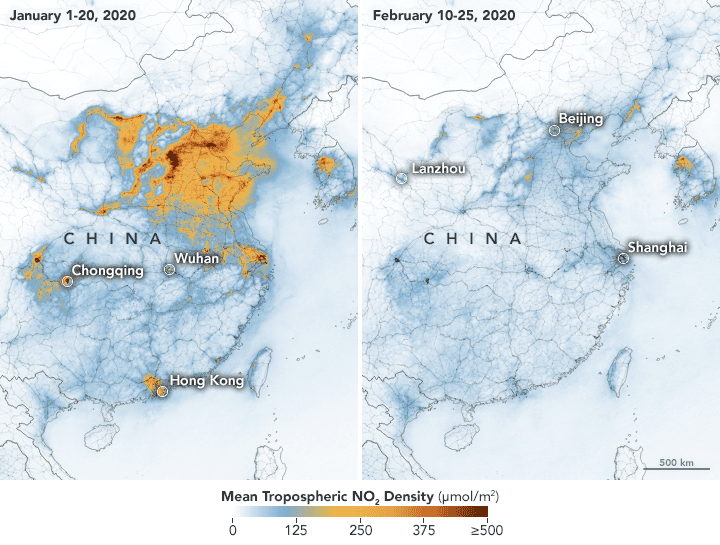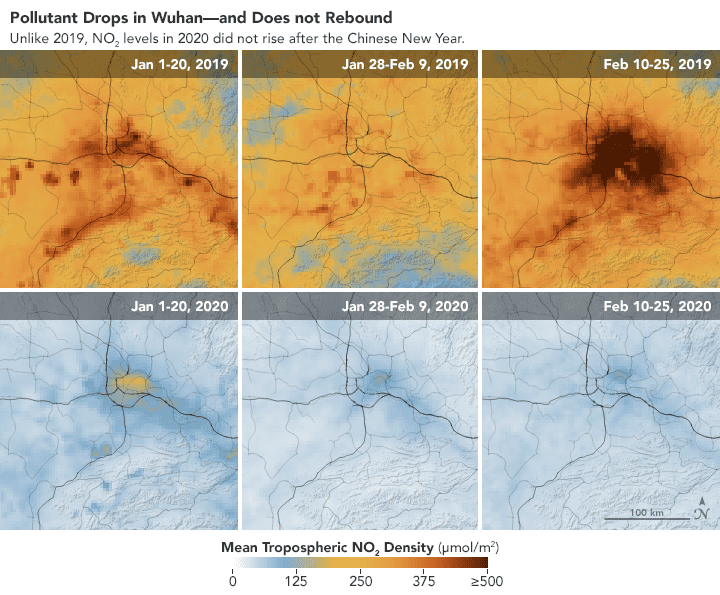Dozens of factories have temporarily shut down across China in a move to try to stop the spread of the coronavirus, with over 80,000 confirmed cases in the country. This had an unexpected secondary effect unrelated to the virus but important to the quality of life in many of China’s polluted cities.

The North American (NASA) and European (ESA) space agency satellites detected in recent weeks a “significant” drop in nitrogen dioxide (NO2) levels in China’s airspace. The reduction can be linked, at least partially, to the economic slowdown following the coronavirus outbreak.
According to NASA scientists, the reduction of NO2 contamination was “evident” for the first-time near Wuhan, where the virus was first detected, but eventually spread throughout the country. In January, transportation was closed to and from Wuhan, as well as local businesses.
“This is the first time I see such a dramatic fall in such a wide area for a specific event,” said Fei Liu, an air quality researcher at NASA’s Goddard Space Flight Center. Liu remembers seeing a fall in NO2 in several countries during the economic recession that began in 2008, but the decline was gradual.
The fall of nitrogen dioxide also coincided with the celebrations of the Lunar New Year in China and much of Asia. In general, companies and factories close to the last week of January to the beginning of February to celebrate the festival. Previous observations have shown that air pollution generally decreases during this period and then increases once the celebration ends.
“There is always a general slowdown at this time of year,” said Barry Lefer, a NASA air quality scientist. “Our long-term IMO data allows us to see if these amounts are abnormal and why.” Launched in 2004, IMO has been collecting global data on NO2 and various air pollutants for more than 15 years.
While the Lunar New Year may have played a role in the recent fall, researchers believe the decline is more than a holiday effect or a weather-related variation. In a preliminary analysis, NASA researchers compared the NO2 values detected by IMO in 2020 with the average amounts detected at this time of 2005-2019.

The NO2 values in eastern and central China were significantly lower (10% to 30% lower) than is normally observed for this period of time, according to NASA. In addition, Liu and his colleagues have not seen a rebound in NO2 after the holidays.
“This year, the reduction rate is more significant than in previous years and has lasted longer,” he said. “It doesn’t surprise me because many cities across the country have taken steps to minimize the spread of the virus.”
According to Carbon Brief, the coronavirus temporarily reduced China’s CO2 emissions by a quarter. The climate website said the demand for electricity and the industrial output are “far below” their usual levels in many indicators. The use of coal is at a four-year low and the output of steel product lines is at its lowest for five years, among others.
A myriad of Chinese cities (including large ones) have extremely poor air quality, according to the recent World Air Quality Report. Nevertheless, they recently showed an improvement with a 9% decrease in the concentration of pollutants compared to last year.









